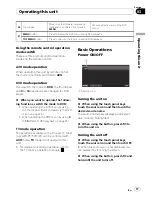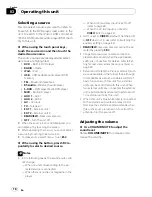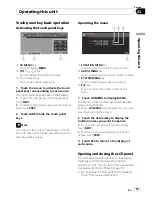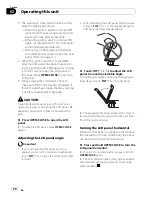
–
Introduction of advanced
operations
64
–
Using CD TEXT functions
64
DVD Player
65
–
Basic Operations
65
–
Selecting a disc
65
–
Selecting a folder
65
–
Pausing disc playback
65
–
Introduction of advanced
operations
66
TV tuner
67
–
Basic Operations
67
–
Storing and recalling broadcast
stations
67
–
Introduction of advanced
operations
68
–
Storing the strongest broadcast
stations sequentially
68
–
Selecting the area group
68
Digital Signal Processor
68
–
Introduction of DSP adjustments
68
–
Using the sound field control
69
–
Using the position selector
69
–
Using balance adjustment
70
–
Adjusting source levels
70
–
Using the dynamic range control
70
–
Using the down-mix function
71
–
Using the direct control
71
–
Using the Dolby Pro Logic II
71
–
Setting the speaker setting
72
–
Adjusting the speaker output
levels
73
–
Selecting a cross-over frequency
73
–
Adjusting the speaker output levels
using a test tone
73
–
Using the time alignment
74
–
Using the equalizer
75
–
Using the auto-equalizer
76
–
Auto TA and EQ (auto-time alignment
and auto-equalizing)
76
Additional Information
Troubleshooting
79
Error messages
81
Understanding auto TA and EQ error
messages
83
Handling guideline of discs and player
84
DVD discs
84
DVD-R/DVD-RW discs
84
AVCHD recorded discs
84
CD-R/CD-RW discs
85
Dual Discs
85
Compressed audio files on the disc
85
–
Example of a hierarchy
86
–
Compressed audio compatibility
86
USB audio player/USB memory
86
–
USB audio player/USB memory
compatibility
86
–
USB audio player/USB memory
86
–
Compressed audio compatibility
87
DivX video files
88
–
DivX compatibility
88
About handling the iPod
88
–
About iPod settings
88
Using the display correctly
89
–
Handling the display
89
–
Liquid crystal display (LCD) screen
89
–
Keeping the display in good
condition
90
–
Small fluorescent tube
90
Language code chart for DVD
91
Terms
92
Specifications
95
Index
97
En
5
Contents






































